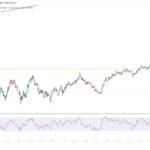DeepSeek’s R1 Upends the AI Value Chain, Sparking an Open-Source Push and Hardware Rally
DeepSeek’s R1 announcement sent shockwaves through the tech market this week, with widespread trading movements and a renewed focus on the hardware-software dynamics that underpin modern AI. The event underlined how a single strategic claim from a Chinese open-source AI player can ripple across global investors, chipmakers, and software incumbents alike. At the heart of the buzz is DeepSeek, a Chinese AI company known for developing open-source large language models (LLMs). The company introduced a new AI model named R1, which it positions as competitive with more expensive U.S. models, built on a framework similar to what OpenAI’s O1 is believed to represent. The immediate market reaction was sharp: several hardware-focused equities, including Nvidia, dropped in trading, as investors speculated about a potential sea change in the demand for high-end compute resources.
The following overview synthesizes what happened, why it matters, and the longer-term implications for the AI value chain. It is intended to capture the core ideas, their interconnections, and the likely trajectories that could shape investment, development, and strategic planning across the next several quarters and years.
DeepSeek, R1, and the competitive landscape
DeepSeek is positioned as a developer of open-source LLMs with the ambition to democratize access to high-performance AI capabilities. Its latest release, the R1 model, is presented as leveraging a design philosophy similar to OpenAI’s O1—namely, an emphasis on robust performance at a comparatively lower cost, harnessed through training approaches that leverage less expensive hardware. The company has characterized the development as costing approximately six million dollars, a figure it asserts is tiny relative to the hundreds of billions typically attributed to rival ecosystems. The assertion, while provocative, has sparked questions and scrutiny from market observers who examine the feasibility, supply chain, and real-world performance of such a claim, including whether access to top-tier hardware, such as Nvidia’s H100 accelerators, played a role in the model’s development strategy.
The broader takeaway from DeepSeek’s framing is the suggestion that significant AI capabilities can be achieved even when relying on more accessible compute environments, potentially lowering the barrier to entry for a larger cadre of developers and companies. This stands in contrast to prevailing narratives that heavy, expensive hardware is a gatekeeper to state-of-the-art AI capabilities. Investors have focused on the juxtaposition: if a credible open-source alternative can deliver performance close to or on par with the best-in-class closed systems, the incentive to pour billions into proprietary compute could be tempered—at least in certain segments of the market.
Yet a careful reading of the situation indicates that the core driver of any meaningful progress in AI capability remains the availability and scale of hardware. The open-source approach may broaden who can participate, but the pace of genuine advancement will still hinge on access to powerful accelerators, data resources, and the ability to deploy and iterate at scale. Moreover, the public framing of cost efficiency and hardware utilization tends to oversimplify the broader economics of AI development. While cheaper models and cheaper training cycles can broaden adoption, the incremental value of marginal hardware improvements, specialized chips, and software optimizations remains substantial for achieving breakthroughs in capability, reliability, and safety.
This dynamic has also highlighted a broader strategic theme: the edge that U.S. and global technology leaders often enjoy is a function not just of software cleverness but of access to advanced hardware ecosystems, robust supply chains, and the capital to finance sustained, large-scale experimentation. The R1 announcement sits squarely at this intersection, reinforcing the notion that hardware parity and access will continue to be a decisive factor in any meaningful leap forward in AI performance.
Competitive positioning and market implications
DeepSeek’s positioning as an open-source model competitor to higher-priced U.S. models creates potential competitive pressure in the mid-to-long term. For developers, startups, and enterprises that value transparency, adaptability, and cost efficiency, open-source models can offer advantages in customization, governance, and integration with existing workflows. For investors, the question becomes whether an open-source alternative can maintain performance parity while remaining economically viable at scale, particularly as the ecosystem around model serving, inference costs, and data privacy continues to mature.
The market’s initial reaction to R1 was colored by concerns about how much of the innovation pipeline would need to rely on high-end hardware. The belief that the “new normal” of AI development could be sustained without outsized hardware investment was met with skepticism, especially among those who view computational throughput as the primary lever for improving model capabilities. Nevertheless, the potential for a broader base of participants—from software vendors to service providers and independent developers—to contribute to AI innovation remains an important long-term tailwind for the AI industry. If open-source models can close the gap on performance while providing greater flexibility and control, the resulting ecosystem could catalyze a new wave of AI-enabled products and services across industries.
The broader industrial and policy context
The DeepSeek event underscores a broader pattern in which major AI advances are increasingly viewed through the lens of global hardware ecosystems and supply chain resilience. The role of U.S.-based hardware developers and fabricators, the availability of specialized accelerators, and the cost dynamics of training and inference shapes both private-sector incentives and public policy considerations. The Open Source vs. Closed Source debate remains central: open-source efforts can accelerate diffusion, community-driven innovation, and vendor-neutral deployment, while closed-source offerings mayAdvantage the provider with stronger control over the deployment environment, safety guardrails, and monetization strategies. In this context, the R1 disclosure prompts a renewed assessment of where competitive advantages come from—whether they arise primarily from algorithmic breakthroughs, data access, architectural innovations, or the infrastructure that supports those breakthroughs.
R1 and the evolution of AI models: Open-source versus closed-source
The discussion around R1 also centers on a broader debate about model accessibility and the sustainability of open-source AI in a landscape where some players rely on proprietary data pipelines, proprietary training techniques, and exclusive access to large-scale compute environments. The open-source model, by design, invites broader participation, which can accelerate innovation and reduce vendor lock-in for customers. However, the open-source approach also faces challenges related to safety, governance, and the long-term maintenance of models that are widely used across diverse contexts.
From a technical standpoint, R1’s described architecture and training approach—if it truly mirrors the principles of a high-performing, expensive model while leveraging cheaper hardware—could imply a reconfiguration of optimization trade-offs. It suggests that the efficiency of training and inference could be improved through smarter software design, quantization techniques, data curation, and distributed training strategies. The potential ripple effects include faster prototyping cycles for AI applications, lower entry costs for research teams and startups, and a diversification of the supplier landscape for AI capabilities beyond a handful of dominant providers.
Nevertheless, the market must scrutinize the veracity of cost and hardware reuse claims. The existence of partial access to advanced accelerators like H100s, if true, would mean that DeepSeek benefited from high-end hardware at least for certain phases of R1’s development. If so, the perceived cost advantage could be less dramatic in practice than stated. The significance for buyers and developers, though, remains: open-source models that demonstrate competitive performance can unlock flexibility, customization, and transparency that are tightly valued in many enterprise contexts, particularly for regulated industries or organizations seeking to minimize vendor dependence.
Implications for software ecosystems and enterprises
For software ecosystems, the prospect of strong open-source models means more opportunities to embed AI capabilities into existing platforms without relying solely on a few dominant providers. Enterprises could experiment with internal copilots, automation agents, and integrated AI workflows that align with internal compliance and governance standards. Agentic AI, a concept related to AI systems that can perform planning and reasoning beyond single-turn interactions, emerges as a key area of interest. Agentic AI holds the promise of delivering proactive, context-aware assistance across service functions—from customer support and content creation to cybersecurity and healthcare. This class of AI could transform how teams operate, enabling more autonomous, capable, and reliable AI-enabled processes.
The broader uptake of agentic AI would likely follow a pattern similar to earlier copilots, expanding across software development, productivity, sales, and specialized domains such as cybersecurity and observability. In practice, this means that companies with large installed software bases could stand to gain disproportionate value from AI-enhanced tools, as these capabilities integrate deeply with existing workflows and data streams. The potential market impact is vast, with credible estimates suggesting that agentic AI could surpass the trillion-dollar benchmark within the next decade, driven by scalable adoption across diverse industries.
Open-source momentum and revenue models
On the commercial side, open-source AI models can support monetization through tangential revenue streams, including professional services, enterprise-grade management tooling, secure deployment, and value-added features around safety and governance. The competitive landscape is likely to see a bifurcation where core model capabilities remain open or freely available in many contexts, while premium features, support, and specialized deployments become the domain of commercial offerings. This dynamic fosters a robust ecosystem where hardware, software, and services co-evolve, reinforcing the importance of a flexible, interoperable AI stack.
Impact on AI applications and the rise of Agentic AI
The market’s attention to R1 is closely tied to the potential implications for AI applications across industries. Agentic AI, which can be envisioned as systems capable of more advanced planning and decision-making than traditional chatbots, is viewed as a pivotal development. Unlike chatbots that produce responses based on a single interaction, Agentic AI is seen as capable of “thinking” across sequences of tasks, leveraging models to reason, plan, and execute actions. This capability could unlock significant productivity gains and enable new business models that rely on AI-driven automation and decision support.
A broad spectrum of applications across services
Agentic AI could transform a wide range of service functions, including customer service, content creation, cybersecurity, and healthcare. In customer service, agents could handle complex inquiries with multi-turn reasoning, offering proactive recommendations and follow-ups. In content creation, AI agents might manage end-to-end workflows, from ideation to publication, with the ability to adjust strategies based on performance data. In cybersecurity, agents could monitor, detect, and respond to threats in real time, coordinating across different tools and teams. In healthcare, AI agents could assist clinicians by synthesizing patient data, recommending treatment options, and coordinating care pathways, all while complying with regulatory and ethical standards.
The hardware-to-application linkage
A critical theme in this discussion is the dependency of these capabilities on hardware ecosystems. While the software abstractions of AI models enable sophisticated tasks, the underlying compute infrastructure accelerates training, inference, and real-time decision-making. The more capable the hardware, the higher the potential ceiling for AI performance, especially as models grow in size and complexity. The market’s reaction to DeepSeek’s R1—marked by concern about a reduced emphasis on high-end hardware—was not merely about a single model but about the perceived signal it sends to compute investment, chip development, and data center expansion. The takeaway is that even as new model paradigms emerge, the demand for specialized hardware remains a central driver of capability acceleration and product differentiation.
Strategic implications for enterprises and developers
For enterprises and developers, the practical implication is that AI strategies should consider both the potential of open-source models and the continuing value of robust hardware investments. Organizations may adopt a hybrid approach: leveraging open-source models for experimentation, customization, and cost efficiency, while also maintaining access to proprietary models or optimized inference engines for mission-critical applications. The balance between openness and control, between cost and performance, will shape procurement decisions, platform strategies, and the pace at which AI capabilities scale within organizations.
Open-source vs. closed-source: market dynamics and competitive pressure
The open-source versus closed-source debate remains central to assessing DeepSeek’s impact. Open-source AI models democratize access, accelerate collaboration, and reduce vendor lock-in. This can translate into rapid adoption, broader experimentation, and a more vibrant ecosystem of developers and partners. Closed-source models, on the other hand, often benefit from tightly managed data pipelines, safety protocols, monetization strategies, and the ability to control deployment environments. The evolving balance between these two modes will influence pricing, service levels, and the availability of specialized features that enterprises value.
Market dynamics and revenue opportunities
As open-source models become more capable, companies that provide complementary services—such as deployment, monitoring, governance, security, and auditing—could find fertile opportunities. The revenue model may increasingly hinge on value-added services, enterprise-grade support, and specialized configurations designed to satisfy compliance and risk-management requirements. Meanwhile, providers of closed-source models will likely continue to monetize through premium features, exclusive access to advanced data or training techniques, and controlled ecosystems. The tension between openness and control will shape competition, pricing, and the pace of ecosystem growth in the AI space.
Competitive strategy implications for incumbents
For established AI vendors and platform operators, the emergence of strong open-source alternatives elevates the importance of differentiating beyond raw model capability. This includes investing in reliability, safety, governance, privacy, and integration capabilities that appeal to enterprise buyers. It also emphasizes the need to foster strong developer ecosystems, ensure interoperability, and provide comprehensive deployment tooling that accelerates time-to-value for customers. The ability to rapidly integrate new innovations, test them in controlled environments, and deliver secure, scalable solutions will be a critical competitive differentiator.
Compute hardware, power, and the investment cycle
The market’s reaction to DeepSeek’s R1 highlighted a broader re-evaluation of the hardware landscape that supports AI development. The decline in stock prices for key hardware players reflected concerns about whether faster, cheaper AI could reduce the demand for cutting-edge accelerators. Yet, the long-run implications suggest a counterintuitive pattern: as AI models become more accessible and affordable at a base level, the demand for specialized hardware to push the boundaries of capability could intensify as companies strive to outperform competitors and build differentiated offerings.
Three major opportunity sets
-
Compute: Nvidia remains a leadership force in the accelerator market, with ongoing interest in custom chips and alternative architectures that could gain traction in 2025. The push toward more efficient and capable compute platforms is likely to continue, driven by the demand for lower latency, higher throughput, and better energy efficiency in AI workloads.
-
Networking: There is meaningful potential for new entrants to bring innovative networking solutions that optimize data movement, bandwidth efficiency, and latency in AI data centers. As models grow larger and training pipelines evolve, advances in interconnect technology and data routing can unlock additional performance gains.
-
Power generation: The power dimension of AI infrastructure has been underinvested for many years, but the sector is entering a cyclical upturn as AI workloads scale and data centers expand. Investments in energy efficiency, cooling solutions, and sustainable power generation will be pivotal in supporting the next wave of AI deployment.
Corporate investment signals
In the wake of the DeepSeek announcement, many major tech companies signaled ongoing and intensified commitments to hardware expansion. Even after a strong year for 2024, several major players have increased capital expenditure, reflecting the expectation that hardware remains a critical enabler of AI advancement. This trend underscores the reality that the AI hardware market—comprising GPUs, chips, memory, interconnects, and power infrastructure—will continue to be a linchpin of the industry’s growth trajectory.
Market reaction, investor sentiment, and strategic thinking
The initial market re-pricing following the DeepSeek news reflected a mix of skepticism, concern about the durability of high-end hardware demand, and a broader reassessment of the cost dynamics in AI development. While some investors feared a potential shift away from heavy hardware investments, others recognized that innovations in model efficiency, software architecture, and deployment strategies could coexist with continued demand for advanced infrastructure. The net effect is a shift in expectations for the AI value chain, with a renewed emphasis on hardware resilience and the strategic value of owning or accessing top-tier accelerators.
Implications for investors and portfolios
For investors, the episode reinforces the importance of evaluating AI opportunities through a multi-layer lens: model performance, cost of training and inference, data governance, safety, and the underlying hardware ecosystem. Diversification across model types—open-source and closed-source—paired with exposure to hardware developers, cloud providers, and AI services, could help manage risk while capturing potential upside from continued AI adoption. It also highlights the need to monitor regulatory developments, supply-chain constraints, and geopolitical dynamics that may influence access to critical compute resources.
Strategic considerations for technology firms
Technology firms evaluating AI investments should consider hybrid strategies that combine open-source experimentation with selective access to premium models or enterprise-grade offerings. This approach allows rapid experimentation, faster time-to-value, and the ability to tailor AI capabilities to specific business processes while maintaining governance and compliance standards. Firms should also invest in capacity planning for data centers and edge deployments to accommodate variable workloads and ensure scalable performance as AI usage expands.
Practical outlook and long-term themes
Looking ahead, several enduring themes are likely to shape the AI landscape in the wake of DeepSeek’s R1 reveal. First, the balance between open-source accessibility and closed-source control will continue to define competitive dynamics, pricing structures, and the breadth of AI adoption across industries. Second, the hardware economy—encompassing GPUs, custom accelerators, networking, and energy infrastructure—will remain a central determinant of how quickly AI capabilities advance and how cost-effective deployment becomes for enterprises of different scales. Third, the emergence of Agentic AI signals a future where AI systems are not merely reactive assistants but proactive operators capable of planning, decision-making, and end-to-end workflow execution. This shift could unlock transformative improvements in productivity and enable new business models that rely on autonomous AI-enabled processes.
The broader implication for policymakers, developers, and business leaders is the need to align incentives toward sustainable innovation. This includes ensuring responsible AI development, establishing interoperable standards, and fostering an ecosystem that can support rapid experimentation while maintaining safeguards around safety, privacy, and accountability. The DeepSeek event reinforces the idea that AI progress is a distributed, multi-faceted enterprise—where software ingenuity, data quality, governance frameworks, and the hardware backbone all play indispensable roles in determining the pace and direction of advancement.
Conclusion
The DeepSeek R1 announcement has underscored several intertwined truths about the AI market. It highlighted the tension between open-source democratization and the entrenched advantages of high-end hardware ecosystems. It showcased how a compelling claim about cost efficiency and hardware usage can trigger immediate market responses and shift attention to the enduring importance of compute infrastructure. It also illuminated the potential for agentic AI to reshape how enterprises operate, driving demand for robust, scalable AI solutions that can reason, plan, and execute across complex workflows.
In this evolving landscape, the key takeaway is that hardware access, model capability, governance, and Ecosystem maturity will together determine who leads in AI over the coming years. Open-source models like R1 can catalyze broader experimentation and adoption, but the sustained pace of advancement will continue to rely on the ability to deploy and iterate at scale on powerful hardware. The market will likely respond to this dynamic with continued investment in accelerators, data centers, energy efficiency, and security tools—while developers and enterprises explore hybrid strategies that combine open-source flexibility with the reliability and safety features offered by premium, managed AI solutions. As AI technologies mature, stakeholders across the value chain—from chipmakers to software developers, from cloud providers to end users—will play collaborative roles in shaping a future where AI capabilities are more accessible, economical, and impactful than ever before.



